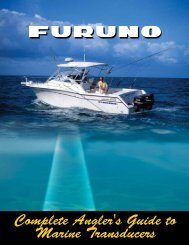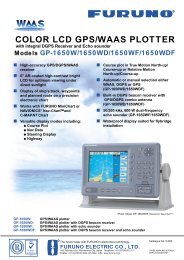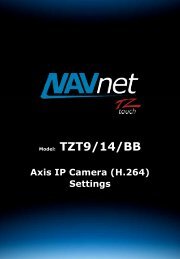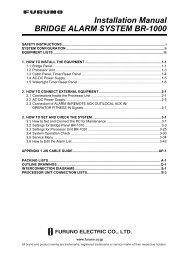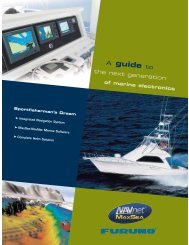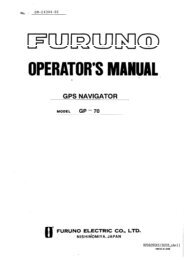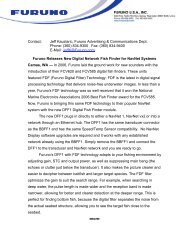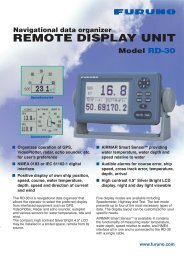Installation Instructions - Airmar Technology Corporation
Installation Instructions - Airmar Technology Corporation
Installation Instructions - Airmar Technology Corporation
You also want an ePaper? Increase the reach of your titles
YUMPU automatically turns print PDFs into web optimized ePapers that Google loves.
Mounting Location<br />
• The water flowing across the hull must be smooth with a<br />
minimum of bubbles and turbulence (especially at high speeds).<br />
Caution:<br />
DO NOT MOUNT near water intake or discharge<br />
openings, or behind strakes, fittings, or hull irregularities.<br />
• The transducer must be continuously immersed in water.<br />
• The transducer beam must be unobstructed by the keel or<br />
propeller shaft(s).<br />
• Choose a location away from interference caused by power and<br />
radiation sources such as: the propeller(s) and shaft(s), other<br />
machinery, other echosounders, and other cables. The lower<br />
the noise level, the higher the echosounder gain setting that<br />
can be used.<br />
• Choose a location with a deadrise angle of 20º or less, so the<br />
transducer beam will be aimed at the bottom.<br />
• Choose an accessible spot inside the vessel with adequate<br />
headroom for the height of the housing, tightening the nuts, and<br />
removing the insert. Allow a minimum of 280mm (11").<br />
2<br />
large displacement hulls small displacement hulls<br />
outboard and I/O<br />
fin keel sailboats<br />
Figure 2.<br />
plastic housing<br />
planing hulls<br />
full keel sailboats<br />
Best location for transducer<br />
Copyright © 2005 <strong>Airmar</strong> <strong>Technology</strong> Corp.<br />
stepped hull<br />
insert<br />
cap nut<br />
(plastic)<br />
housing<br />
safety wire<br />
hull nut<br />
washer<br />
hull<br />
Hull Types (see Figure 2)<br />
• Displacement hull powerboats—Locate<br />
amidships near the<br />
centerline. The starboard side of the hull where the propeller<br />
blades are moving downward is preferred.<br />
• Planing hull powerboats—Mount<br />
well aft, on or near the<br />
centerline, and well inboard of the first set of lifting strakes to insure<br />
that the transducer will be in contact with the water at high speeds.<br />
The starboard side of the hull where the propeller blades are<br />
moving downward is preferred.<br />
Outboard and I/O—Mount<br />
just forward of the engine(s).<br />
Inboard—Mount<br />
well ahead of the propeller(s) and shaft(s).<br />
Stepped hull—Mount<br />
just ahead of the first step.<br />
Boat capable of speeds above 25kn (29MPH)—Review the<br />
installation location and operating results of similar boats before<br />
proceeding.<br />
• Fin keel sailboats—Mount<br />
on or as close as possible to the<br />
centerline and forward of the fin keel 300–600mm (1–2').<br />
• Full keel sailboats—Locate<br />
amidships and away from the keel<br />
at the point of minimum deadrise.<br />
<strong>Installation</strong><br />
Cored fiberglass hull—Follow<br />
separate instructions on page 3.<br />
Hole Drilling<br />
Warning:<br />
Always wear safety goggles and a dust mask.<br />
1. Drill a 3mm or 1/8" pilot hole from inside the hull. If there is a rib,<br />
strut or other hull irregularity near the selected mounting<br />
location, drill from the outside.<br />
2. Using the appropriate size hole saw, cut a hole from outside the hull.<br />
Flush housing—Use<br />
a countersink tool to create a seat in the hull.<br />
3. Sand and clean the area around the hole, inside and outside, to<br />
ensure that the sealant will adhere properly to the hull. If there is any<br />
petroleum residue inside the hull, remove it with either mild<br />
household detergent or a weak solvent (alcohol) before sanding.<br />
Metal hull—Remove<br />
all burrs with a file and sandpaper.<br />
Bedding<br />
metal housing in non-metal<br />
hull<br />
Caution:<br />
A stainless steel housing must be isolated from a metal<br />
hull to prevent electrolytic corrosion.<br />
Apply a 2mm (1/16") thick layer of marine sealant around the lip of<br />
the housing that contacts the hull and up the sidewall of the<br />
housing (see Figure 3). The sealant must extend 6mm (1/4")<br />
higher than the combined thickness of the hull, the washer(s), and<br />
BOW ➤<br />
stainless steel housing in metal hull<br />
cap nut<br />
(plastic)<br />
safety wire<br />
housing<br />
hull nut<br />
washer<br />
hull (metal)<br />
isolation<br />
ring<br />
marine sealant on lip<br />
and sidewall of housing<br />
marine sealant on lip<br />
and sidewall of housing<br />
Figure 3. Bedding and installing— DT800V shown<br />
Copyright © 2005 <strong>Airmar</strong> <strong>Technology</strong> Corp.<br />
marine sealant on lip and<br />
sidewall of housing<br />
and isolation ring where it contacts hull<br />
insert



